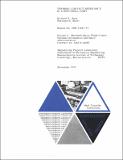Thermal contact resistance in a non-ideal joint
Author(s)
Roca, Richard T.; Mikic, B. B.
DownloadHTL_TR_1971_077.pdf (10.42Mb)
Other Contributors
Massachusetts Institute of Technology. Division of Sponsored Research.
Massachusetts Institute of Technology. Dept. of Mechanical Engineering.
Massachusetts Institute of Technology. Heat Transfer Laboratory.
Metadata
Show full item recordAbstract
The contact conductance at an interface can be determined by knowing the material and surface properties and the interfacial pressure distribution. This pressure distribution can be influenced strongly by the roughness of the mating surfaces but until now this effect has been ignored in studies of joint conductance. This thesis considers this effect and shows the circumstances when it is an important factor. Furthermore, it is shown that one can either raise or lower the total resistance of a joint by changing the surface properties in the proper manner for the particular system being considered. Specifically, this thesis deals with three systems: the contact of two rough, wavy surfaces; the contact of two rough but nominally flat plates pressed together over a concentrated area; and the contact of two rough but nominally flat plates bolted together. In each case the pressure distribution is calculated as a function of the surface properties. In the case of wavy surfaces it is found that all necessary information for any combination of parameters can be reduced to one master graph. In the other two cases one such graph is needed for each geometry used. The resulting pressure distributions are used in a specific heat transfer example and the total joint resistance versus roughness is presented. It is shown how one can actually decrease the resistance by increasing the roughness - a seemingly contradictory phenomenon. Heat transfer experiments performed by Joseph Pigott qualitatively confirmed the theoretical findings.
Date issued
1971Publisher
Cambridge, Mass. : M.I.T. Dept. of Mechanical Engineering, [1971]
Other identifiers
14091221
Series/Report no.
Technical report (Massachusetts Institute of Technology, Heat Transfer Laboratory) ; no. 77.
Keywords
Joints (Engineering), Heat -- Conduction., Surfaces (Technology), Thermal stresses.